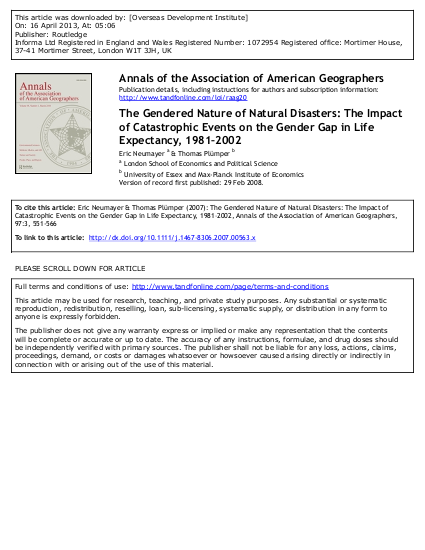
Natural disasters do not affect people equally. A vulnerability approach to disasters would suggest that inequalities in exposure and sensitivity to risk as well as inequalities in access to resources, capabilities, and opportunities systematically disadvantage certain groups of people, rendering them more vulnerable to the impact of natural disasters. This article addresses the specific vulnerability of girls and women with respect to mortality from natural disasters and their aftermath. Biological and physiological differences between the sexes are unlikely to explain large-scale gender differences in mortality rates. Social norms and role behaviours provide some further explanation, but what is likely to matter most is the everyday socio-economic status of women. In a sample of up to 141 countries over the period 1981–2002, researchers analysed the effect of disaster strength and its interaction with the socioeconomic status of women on the change in the gender gap in life expectancy. They found, first, that natural disasters lower the life expectancy of women more than that of men. In other words, natural disasters (and their subsequent impact) on average kill more women than men or kill women at an earlier age than men. Since female life expectancy is generally higher than that of males, for most countries natural disasters narrow the gender gap in life expectancy. Second, the stronger the disaster (as approximated by the number of people killed relative to population size), the stronger this effect on the gender gap in life expectancy. That is, major calamities lead to more severe impacts on female life expectancy (relative to that of males) than do smaller disasters. Third, the higher women’s socio-economic status, the weaker is this effect on the gender gap in life expectancy. Taken together, these results show that it is the socially constructed gender-specific vulnerability of females built into everyday socio-economic patterns that leads to the relatively higher female disaster mortality rates compared to men.
